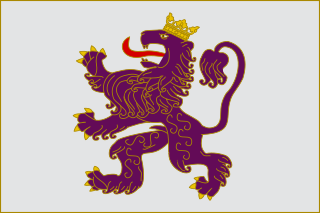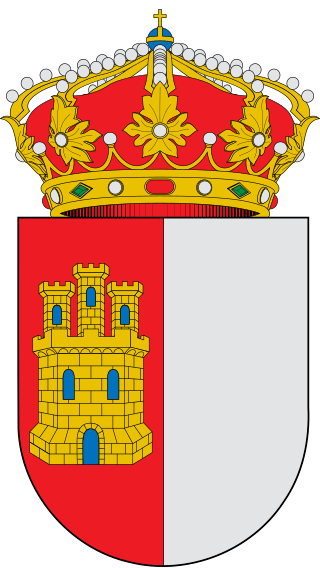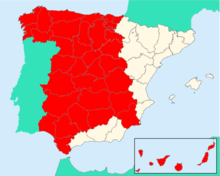
The Iberian Peninsula, also known as Iberia, is a peninsula in Southwestern Europe, defining the westernmost edge of Eurasia. It is divided between Peninsular Spain and Continental Portugal, comprising most of the region, as well as Andorra, Gibraltar and a small part of Southern France. With an area of approximately 583,254 square kilometres (225,196 sq mi), and a population of roughly 53 million, it is the second-largest European peninsula by area, after the Scandinavian Peninsula.

The Reconquista or the reconquest of al-Andalus was the series of military campaigns that Christian kingdoms waged against the Muslim kingdoms following the Umayyad conquest of Hispania. The beginning of the Reconquista is traditionally dated to the Battle of Covadonga, in which an Asturian army achieved the first Christian victory over the forces of the Umayyad Caliphate since the beginning of the military invasion. Its culmination came in 1492 with the fall of the Nasrid kingdom of Granada to the Catholic Monarchs.
Castile or Castille is a territory of imprecise limits located in Spain. The use of the concept of Castile relies on the assimilation of a 19th-century determinist geographical notion, that of Castile as Spain's centro mesetario with a long-gone historical entity of diachronically variable territorial extension.

Castile and León is an autonomous community in northwestern Spain. It was created in 1983 by the merging of the provinces of the historic region of León: León, Zamora and Salamanca with those of Old Castile : Ávila, Burgos, Palencia, Segovia, Soria and Valladolid. The provinces of Santander and Logroño, which until then had been included in the Old Castile administrative division, opted out of this merger and formed the new Autonomous Communities of Cantabria and La Rioja respectively.

In Spain, music has a long history. It has played an important role in the development of Western music, and has greatly influenced Latin American music. Spanish music is often associated with traditional styles such as flamenco and classical guitar. While these forms of music are common, there are many different traditional musical and dance styles across the regions. For example, music from the north-west regions is heavily reliant on bagpipes, the jota is widespread in the centre and north of the country, and flamenco originated in the south. Spanish music played a notable part in the early developments of western classical music, from the 15th through the early 17th century. The breadth of musical innovation can be seen in composers like Tomás Luis de Victoria, styles like the zarzuela of Spanish opera, the ballet of Manuel de Falla, and the classical guitar music of Francisco Tárrega. Nowadays commercial pop music dominates.

The Spanish language has two names: español and castellano. Spanish speakers from different countries or backgrounds can show a preference for one term or the other, or use them indiscriminately, but political issues or common usage might lead speakers to prefer one term over the other. This article identifies the differences between those terms, the countries or backgrounds that show a preference for one or the other, and the implications the choice of words might have for a native Spanish speaker.

The Kingdom of León was an independent kingdom situated in the northwest region of the Iberian Peninsula. It was founded in 910 when the Christian princes of Asturias along the northern coast of the peninsula shifted their capital from Oviedo to the city of León. The kings of León fought civil wars, wars against neighbouring kingdoms, and campaigns to repel invasions by both the Moors and the Vikings, all in order to protect their kingdom's changing fortunes.

The Catholic Monarchs were Queen Isabella I of Castile and King Ferdinand II of Aragon, whose marriage and joint rule marked the de facto unification of Spain. They were both from the House of Trastámara and were second cousins, being both descended from John I of Castile; to remove the obstacle that this consanguinity would otherwise have posed to their marriage under canon law, they were given a papal dispensation by Sixtus IV. They married on October 19, 1469, in the city of Valladolid; Isabella was 18 years old and Ferdinand a year younger. It is generally accepted by most scholars that the unification of Spain can essentially be traced back to the marriage of Ferdinand and Isabella. Their reign was called by W.H. Prescott "the most glorious epoch in the annals of Spain".
Castilian or Castillian may refer to:

Spaniards, or Spanish people, are an ethnic group native to Spain. Within Spain, there are a number of national and regional ethnic identities that reflect the country's complex history, including a number of different languages, both indigenous and local linguistic descendants of the Roman-imposed Latin language, of which Spanish is the largest and the only one that is official throughout the whole country.

Iberism, also known as pan-Iberism or Iberian federalism, is the pan-nationalist ideology supporting a unification of all the territories of the Iberian Peninsula. It mostly encompasses Andorra, Portugal and Spain, but may also include: Gibraltar and territories of France such as Northern Catalonia or the French Basque Country.

Spanish is a Romance language which developed from Vulgar Latin in central areas of the Iberian peninsula and has absorbed many loanwords from other Romance languages like French, Occitan, Catalan, Portuguese, and Italian. Spanish also has lexical influences from Arabic and from Paleohispanic languages such as Iberian, Celtiberian and Basque.

The Kingdom of Valencia, located in the eastern shore of the Iberian Peninsula, was one of the component realms of the Crown of Aragon.

The Crown of Castile was a medieval polity in the Iberian Peninsula that formed in 1230 as a result of the third and definitive union of the crowns and, some decades later, the parliaments of the kingdoms of Castile and León upon the accession of the then Castilian king, Ferdinand III, to the vacant Leonese throne. It continued to exist as a separate entity after the personal union in 1469 of the crowns of Castile and Aragon with the marriage of the Catholic Monarchs up to the promulgation of the Nueva Planta decrees by Philip V in 1715.

The language known today as Spanish is derived from spoken Latin, which was brought to the Iberian Peninsula by the Romans after their occupation of the peninsula that started in the late 3rd century BC. Today it is the world's 4th most widely spoken language, after English, Mandarin Chinese and Hindi. Influenced by the peninsular hegemony of Al-Andalus in the early middle ages, Hispano-Romance varieties borrowed substantial lexicon from Arabic. Upon the southward territorial expansion of the Kingdom of Castile, Hispano-Romance norms associated to this polity displaced both Arabic and the Mozarabic romance varieties in the conquered territories, even though the resulting speech also assimilated features from the latter in the process. The first standard written norm of Spanish was brought forward in the 13th century by Alfonso X the Wise, probably drawing from the speech of the upper classes of Toledo. Features associated with the Castilian patterns of Hispano-Romance also spread west and east to the kingdoms of León and Aragón for the rest of the middle ages, owing to the political prestige achieved by the Kingdom of Castile in the peninsular context and to the lesser literary development of their vernacular norms. From the 1560s onward the standard written form followed Madrid's.
Castile, Castille or Castilla may refer to:
In English, Castilian Spanish can mean the variety of Peninsular Spanish spoken in northern and central Spain, the standard form of Spanish, or Spanish from Spain in general. In Spanish, the term castellano (Castilian) can either refer to the Spanish language as a whole, or to the medieval Old Spanish, a predecessor to Early Modern Spanish.

Both the perceived nationhood of Spain, and the perceived distinctions between different parts of its territory derive from historical, geographical, linguistic, economic, political, ethnic and social factors.

Hispania was the Roman name for the Iberian Peninsula and its provinces. Under the Roman Republic, Hispania was divided into two provinces: Hispania Citerior and Hispania Ulterior. During the Principate, Hispania Ulterior was divided into two new provinces, Baetica and Lusitania, while Hispania Citerior was renamed Hispania Tarraconensis. Subsequently, the western part of Tarraconensis was split off, initially as Hispania Nova, which was later renamed "Callaecia". From Diocletian's Tetrarchy onwards, the south of the remainder of Tarraconensis was again split off as Carthaginensis, and all of the mainland Hispanic provinces, along with the Balearic Islands and the North African province of Mauretania Tingitana, were later grouped into a civil diocese headed by a vicarius. The name Hispania was also used in the period of Visigothic rule.

The coat of arms of the Castilla–La Mancha is described in the Spanish Law 1 of 30 June 1983, the Law of the coat of arms of Castilla-La Mancha Region and further regulated by Decree 132 of 5 July 1983, approving the official design of the coat of arms of Castilla-La Mancha and Decree 115 of 12 November 1985, supplementing Decree 132/1983.















